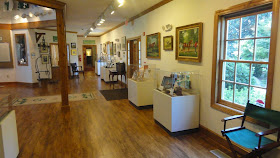Camden, the first inland city founded (1732) in the state, is my kind of town. Gracious homes, many of them antebellum, sit regally on large, heavily-treed lots, and signs of horse culture are everywhere.
A horse-lover since birth, my nose twitched happily at the familiar aroma of leather and hay and my eyes spied the signs from horse-fenced pastures to the ones warning riders that horses are not allowed on the sidewalks.
Suzi Sale, tourism development director for Camden, filled us in on some of the city's history. Camden was on the Catawba trade path and
King Haigler, whose face we had seen on Catawba pottery, is considered its patron saint for all the help he gave early residents.
The town had a large British presence, including General Cornwallis, and the
Battle of Camden (August 1780) was one of the patriots' biggest losses. The next confrontation a year later, the
Battle of Hobkirk's Hill, although a loss for the Patriots, prompted the British to abandon the city.
 |
| Bloomsbury House, built between 1849 and 1854 by South Carolina's third-richest man for his daughter, is now the Bloomsbury Inn, a bed and breakfast. |
During the Civil War, Sherman's troops didn't go through Camden, sparing its homes for future generations.
Today, the invasion is of equine enthusiasts who swell the town's population by 10,000 February through April for the
Carolina Cup steeplechase in March (March 28, 2015) then return for the
Marion du Pont Scott Colonial
Cup in November (Nov. 15, 2014) at
Springdale Race Course.
Between those, the
Camden Training Center and the
South Carolina Equine Center, Suzi said there's an equine event of some sort every weekend year-round with the season running late September through May.
 |
| A life-sized statue of Lonesome Glory, five-time Horse of the Year, fronts The National The Steeplechase Museum . |
It made sense to locate
The National Steeplechase Museum, the only one in the country, in the Steeplechase Capital of the world so that's where we headed next.
 |
| Colors of Mrs. George M. Sensor, owner of 2014 Carolina Cup winner Top Striker. |
 |
| Colors of Gregory D. Hawkins, owner of 2013 Colonial Cup winner Alajmal. |
At the entrance of the Camden cottage-style building you encounter two lawn jockeys painted in the colors of the most recent winners of the Carolina and Colonial Cups races.
Inside, if you're lucky, you meet
Hope Cooper, executive director.
Hope gave us a tour of the museum and information about steeplechasing, which, like all other forms of racing, began when one owner turned to another and said, "Mine is faster than yours."
In Ireland and England during the 17th century, church steeples were the most easily points for starts and finishes. Racers had to negotiate any obstacles - walls, hedges, creeks - in between and the steeplechase was born. When the numbers of proud horsemen grew, courses were laid on which more than two horses at a time could race and the sport as we know it today was formed. By the mid 19th century race meets were being held along America's East coast.
 |
| Scene from The Grand National by Paul Brown. |
Since 1927, steeplechase racing has been a highlight of life in Camden; the museum is adjacent to Springdale Race Course. Today there are two divisions, steeplechases with wooden rail jumps and those with brush jumps like large hedges. The Carolina Cup falls in the latter category. Races are 2 to 2 1/2 miles in length with 12 to 17 fences and last about 4 minutes.
Steeplechase riders weigh in at around 130 pounds compared to flat race jocks at 112 pounds. Most are from England and Ireland; only one American rider was on last year's card. Unlike Thoroughbreds that race at 2, steeplechasers aren't allowed to race until the age of 3, giving legs an extra year to strengthen for the jumping efforts.
 |
| Winners' silks and trophies. |
Purses are smaller and oh, in South Carolina there is no pari mutual wagering, putting steeplechasing more on the level of a sport than a business.
 |
| Jockey silks surround the second floor cupola. |
The museum is spacious and airy with silks of winning owners displayed around the second story cupola. Winners' plates and trophies fill niches, paintings and photographs of influential participants and famous horses on the walls.
 |
| Spacious and interesting. |
In the library are 19 originals of England's The Grand National, the pinnacle of steeplechase races, by famed equine illustrator Paul Brown.
 |
| It wasn't the time for Judy to get in the saddle. |
A favorite is the "trainer," a mechanical horse tacked with a race
saddle that visitors can mount and see just how strong a jockey has to
be.
 |
| Hope Cooper shows Debi the proper racing form. |
 |
| Debi was laughing but admitted it was a lot harder than she expected. |
I was dying to try it but with a slippy hip and knee-immobilizing brace, Debi had to do the honors. Yet another "next time".
 |
| Springdale Race Course grounds. |
Walk out to the patio and you can see the grounds of Springdale Race Course. Makes you want to sit, relax and wait for the next race.















































